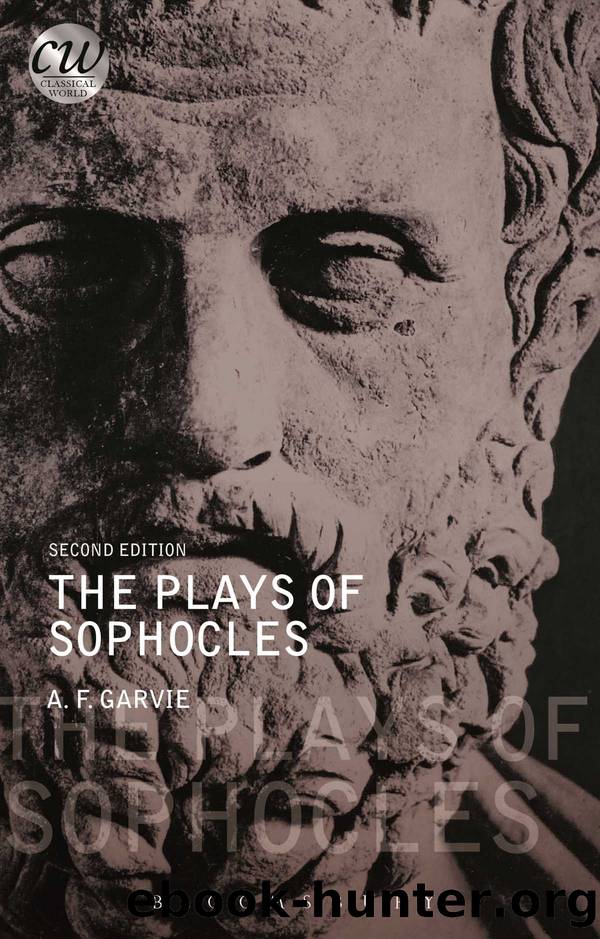The Plays of Sophocles by A. F. Garvie;

Author:A. F. Garvie; [Garvie, A.F.]
Language: eng
Format: epub
ISBN: 9781474233378
Publisher: Bloomsbury UK
Published: 2016-08-20T00:00:00+00:00
Electra
On his return home from the Trojan War Agamemnon was murdered by his wife Clytaemnestra and her lover Aegisthus. Orestes, Agamemnonâs son, comes home from exile, is recognized by his sister Electra, and takes vengeance on his fatherâs murderers. The story, already alluded to in Homerâs Odyssey, was the subject of Aeschylusâ Libation Bearers, produced in 458 BC. It was treated also by Euripides in his Electra. The dates of Sophoclesâ and Euripidesâ plays are unfortunately unknown, so that, while it is clear that they were both influenced by Aeschylusâ version, it is impossible to know for sure which of the two younger playwrights had the otherâs play in front of him. Since, however, Euripidesâ version represents the more radical departure from the traditional story, one may argue that it was the last of the three to be composed.
All three plays, like Women of Trachis, can be assigned to the group of tragedies which deal with the homecoming of a hero after a long absence abroad. In Libation Bearers the main action focuses on Orestesâ vengeance, and Electra disappears from the stage before that vengeance takes place. But both Sophocles and Euripides shift the focus, as the titles of their plays indicate, from the hero to Electra, the subordinate waiting woman in the traditional âreturn-storyâ (see p. 19). Whereas in Aeschylus the recognition-scene between Orestes and Electra occurs early in the play, and in Euripides comparatively early, the most notable feature of Sophoclesâ play-construction is that it comes almost at the end, and is given an unusually full treatment, while the actual killing of Clytaemnestra and Aegisthus is handled very briefly, and almost perfunctorily, in the final scene. If we can find the answer as to why Sophocles has arranged matters in this way, we may have found also the key to understanding his whole dramatic concept.
It may be helpful to work backwards from the recognition-scene to the beginning of the play, as Sophocles may conceivably have done himself as he planned its construction. The recognition cannot come until Electra, in a scene climactic for her emergence as a Sophoclean hero, has made her great decision to kill the murderers herself. But that scene has to follow the false news brought by the old Paedagogus (the servant who had looked after Orestes as a child) that her beloved brother Orestes is dead. Until now she has depended on Orestes to carry out the vengeance, but now she âknowsâ that she is alone, so that she will have to do the job herself. If, however, we are to understand the effect of the âMessenger-sceneâ on Electra, Sophocles must first present to us her emotional state when she still hopes that her brother will return. Every scene is in exactly the right place, and the structure of the play seems almost inevitable.
We have not yet, however, gone back quite to the beginning. The play is set in front of the royal palace at Mycenae, the door of which will be the relentless focus of most of the action.
Download
This site does not store any files on its server. We only index and link to content provided by other sites. Please contact the content providers to delete copyright contents if any and email us, we'll remove relevant links or contents immediately.
| Acting & Auditioning | Broadway & Musicals |
| Circus | Direction & Production |
| History & Criticism | Miming |
| Playwriting | Puppets & Puppetry |
| Stage Lighting | Stagecraft |
Call Me by Your Name by André Aciman(18989)
Ready Player One by Cline Ernest(12863)
How to Be a Bawse: A Guide to Conquering Life by Lilly Singh(6701)
Wiseguy by Nicholas Pileggi(4601)
The Kite Runner by Khaled Hosseini(4472)
On Writing A Memoir of the Craft by Stephen King(4221)
The Crown by Robert Lacey(4115)
Audition by Ryu Murakami(4107)
Call me by your name by Andre Aciman(4079)
Harry Potter and the Cursed Child: The Journey by Harry Potter Theatrical Productions(3983)
Gerald's Game by Stephen King(3927)
The Perils of Being Moderately Famous by Soha Ali Khan(3789)
Dialogue by Robert McKee(3593)
Dynamic Alignment Through Imagery by Eric Franklin(3498)
Apollo 8 by Jeffrey Kluger(3205)
How to be Champion: My Autobiography by Sarah Millican(3193)
Seriously... I'm Kidding by Ellen DeGeneres(3106)
Darker by E L James(3093)
History of Dance, 2E by Gayle Kassing(3001)
